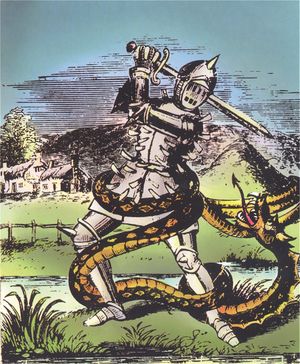Dragon of Loschy Hill
The Dragon of Loschy Hill or Nunnington dragon is a legendary beast from the folklore of Yorkshire, England.
Description
This dragon was known for having a deadly tongue with a poisonous lethal outcome and teeth that were reputed to be equal to the size of pitchfork prongs.
Story
Peter Loschy wore a suit of armour that was studded with sharp blades. When the dragon coiled around him it was cut in pieces by the blades and by Loschy’s sword.
But the Nunnington dragon had the power of regeneration and kept reconnecting its cut parts to become whole again. Then, Peter hacked away at the tongue until it was dead, whilst his faithful hound carried the pieces to a hill about a mile away, this prevented its regeneration. It is said that the hound was so happy to serve his master that after completing the task he licked his master's face. Alas this served as an ill-omen for both of them, with the poison taking hold. Both are said to be buried in Nunnington Church.
The following account of the legend of the Dragon of Loschy Hill was detailed in the 1888 book ‘Yorkshire Legends and Traditions’ by Rev Thomas Parkinson who quoted his source as being an article entitled Serpent Legends of Yorkshire from the Leisure Hour (May 1878).
In the church of Nunnington, in the North Riding of Yorkshire, is an ancient tomb, surmounted by the figure of a knight in armour, in a recumbent posture, the legs crossed, the feet resting against a dog, the hands apparently clasping a heart, but no inscription to determine to whom the monument belongs. The traditional account current in the neighbourhood is that it is the tomb of Peter Loschy, a famous warrior, whose last exploit was killing a huge serpent, or dragon, which infested the country, and had its den on a wooded eminence called Loschy Hill, near East Newton, in the parish of Stonegrave.
The details of the combat, as related by tradition, are as follows:
Having determined to free the country from the pest, the redoubted Peter Loschy had a suit of armour prepared, every part of it being covered with razor-blades set with the edges outwards; and thus defended, armed only with his sword, and accompanied by a faithful dog, he went forth to seek the destroyer, which he quickly found in a thicket on Loschy Hill.
The dragon, glad of another victim, darted upon the armed man, notwithstanding a wound from his sword, and folded itself around his body, intending, no doubt, as it had often done before, to squeeze its victim to death, and afterwards to devour it at leisure; but in this it was disappointed. The razor-blades were keen, and pierced it in every part, and it quickly uncoiled itself again, when, to the great surprise of the knight, as soon as it rolled on the ground its wounds instantly healed, and it was strong and vigorous as ever; and a long and desperate fight ensued between the knight and the serpent, without much advantage to either. At length the sword of the knight severed a large portion of the serpent, which the dog quickly snatched up in his mouth, an ran across the valley with it nearly a mile, and there left it on a hill near Nunnington Church, and immediately returned to the scene of combat, and, snatching up another fragment, cut off in the same manner, conveyed it to the same place, and returned again and again for other fragments until they were all removed, the last portion conveyed being the poisonous head. The knight, now rejoicing at his victory, stooped to pat and praise his faithful dog; the latter, overjoyed, looked up and licked the knight's face, when, sad to relate, the poison of the serpent imbibed by the dog was inhaled by the knight, and he fell down dead in the moment of victory, and the dog also died by the side of his master.
The villagers buried the body of the knight in Nunnington Church, and placed a monument over the grave, on which were carved the figures of the knight and his faithful dog, to witness to the truth of the story.
